MathGrapher
Free Mathematical Graphing Tool
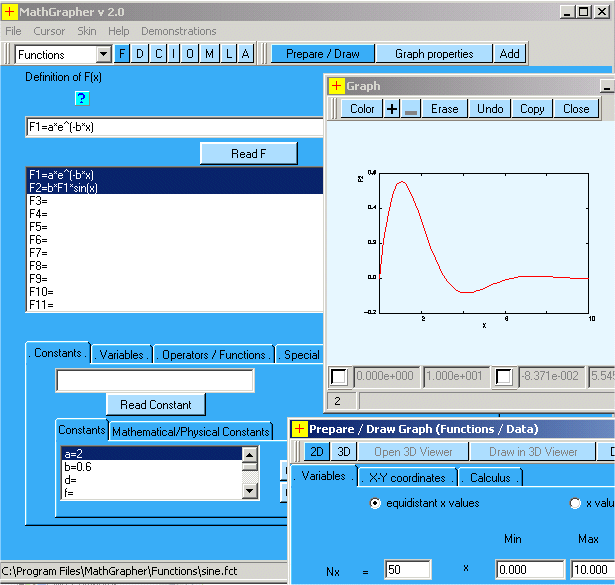
A mathematical graphing tool for students, scientists and engineers. Draw and analyse Functions and Data in 2D and 3D. Draw surface graphs, contour plots and cross-sections through contour plots. Includes linear and nonlinear curve fitting, integration and analysis of coupled ordinary differential equations, iteration and analysis of multi-dimensional maps, matrix operations, Lindenmayer systems and some cellular automata.
MathGrapher is built with Lahey Fortran, IMSL maths libraries and all modules of GINO to handle the graphics and User-interface. It is available as a free download and contains comprehensive help as well as many demonstrations to guide you through the usage.
Further details can be found at MathGrapher
National Inst. of Economic & Social Research UK
Modelling the World Economy
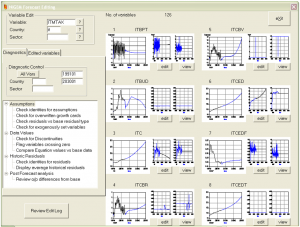
NiGEM is a software forecasting and simulation tool developed by the National Institute of Economic and Social Research. It is an estimated, theoretically coherent forward-looking model, designed as a tool for both practical forecasting and for academically defendable policy analysis of the world economy. It covers all OECD countries, including models for Mexico, South Korea, China, Russia, Hong-Kong, Taiwan, Brazil, Australia and New Zealand. Group models for Latin America, Africa, East Asia and Developing Europe and OPEC are also available. The model is used internally by NIESR for the Institute’s quarterly forecast, and externally, it is used by a group of 50 model subscribers, mainly in the policy community, including the ECB, the central banks of the UK, France, Italy, Netherlands, Spain, Belgium, Denmark, Portugal and Sweden, and a number of finance ministries as well as the ESRI in Japan.
Recent policy analysis included an evaluation of the impact of US proposals for a Chinese revaluation. The modeling of the Chinese economy suggests that it is very responsive to shocks, and a revaluation would lead to rapid deflation. The real exchange rate would therefore return to where it had been previously. Hence it was suggested that realignment was a solution to the overheating of the Chinese economy, but that it would not help improve the US current account except in the short run.
NIESR has been using GINO since 1993, with GINOGRAF used to produce the graphics output and GINOMENU being used for the NiGEM user-interface. In previous versions, data was edited manually via standard text-editors. Now with the use of the RTF editor built into GINOMENU, the data can be edited while running the model and the modified graphical output can be viewed immediately. “GINO’s output flexibility and the integration between its graphics and user-interface modules saves the usual mixed-language programming problems and ensures updates to the program can be implemented with ease and on-time” says Dr. Ian Hurst, Chief Technical Architect of NiGEM. for further information on NiGEM, visit NIESR
Lotus Engineering
Engine Simulation and Concept Valve Train
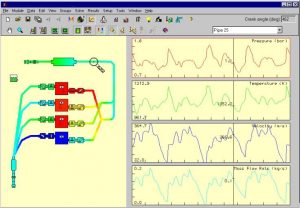
Computer simulation is now a key part of the automotive development process. Lotus Engineering Software has been developed by automotive engineers whilst using them on many powertrain and vehicle projects at Lotus over the past 15 years. The philosophy under-pinning Lotus Engineering Software is to offer simulation tools which enable the user to generate models very quickly, using a mixture of embedded design criteria and well-structured interface functionality. A large number of alternative valve train mechanisms have been developed over the years to operate the poppet valves of the internal combustion engine. An alternative approach to motion definition is being investigated using the visual and flexible availability of GINO and GINOMENU. The availability of Bezier curves within GINO coupled with an increase in the use of multiple spline based approaches to cam profile design within the automotive industry provides a potential solution.
KEK, Japan
High Energy Accelerator Research Org.
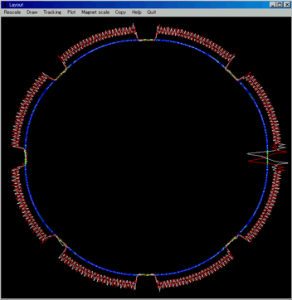
The Large Hadron Collider (LHC) based at CERN, Switzerland consists of two intersecting rings. Up to now, accelerator physicists have never represented the common region of the ring with a ‘proper’ object oriented approach.
KEK, in association with CERN have written a software library for polymorphic tracking (PTC) which permits a more realistic representation of complex accelerators. In particular, common magnets are not cloned, but exist individually in computer memory as they do in a real accelerator.
To check the correctness of this approach in the case of complex ring topologies, it has been necessary to visualize simple orbits of the accelerator on the screen and this has been achieved using GINO and in particular GINOMENU Studio which has been used to greatly speed up the development of over 440 user-interface controls. In addition, the GINO application has been used in connection with the Japan Proton Accelerator Research Project Complex (J-PARC), ORBIT, software from Oak Ridge National Laboratory, USA for the study of space charge effects, and at Brokhaven National Laboratory for the design of FFAGs (Fixed-field alternating-gradient accelerators).
for further information about KEK, visit KEK Website
for a white paper describing GINO’s use at KEK in more detail, visit KEK White Paper
HYDROInform Ltd
Advanced Hydroinformatics Tools for Water Management
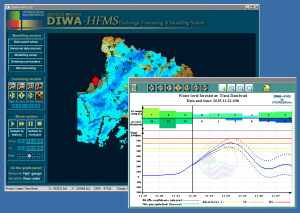
Hydroinformatics is a quickly developing area of computer-aided water management and control which highly integrates the knowledge and understanding of environmental processes, the state of advanced developments in algorithmic mathematics, the highly developed environmental monitoring techniques and the most up-to-date computer technology, into a well designed software application in order to support complex decision making. According to this interpretation, hydroinformatics is a strong interdisciplinary field of research, system-development and consulting that links water and environmental problems with a range of computational modelling methods and the high level condition of computer technology.
HYDROInform has developed numerous software solutions, applications and high level software systems, especially for the purpose of hydroinformatics. With most emphasis in recent years of extensive scientific development HYDROInform Ltd has developed a large-scale high resolution distributed hydrological model DIWA (DIstributed WAtershed) which is a dynamic water-balance hydrological model that is distributed both in space and its parameters, and which was developed along combined principles, but is mostly based on physical foundations. Then the DIWA model has been integrated into the DIWA-HFMS software system, which is a fully interactive and user-friendly decision support system for real-time hydrologic forecasting and supporting decision-makers in case of flood events.
All the communication and visualisation components of the DIWA-HFMS has been developed using GINO modules. The user-menus, the graphic frames, as well as the interactivity management are all managed under GINO.
Developing using GINO is quite easy, and allows us to concentrate on the core of our problem, instead of the deep details of high level programming.
For further information, visit HYDROInform
